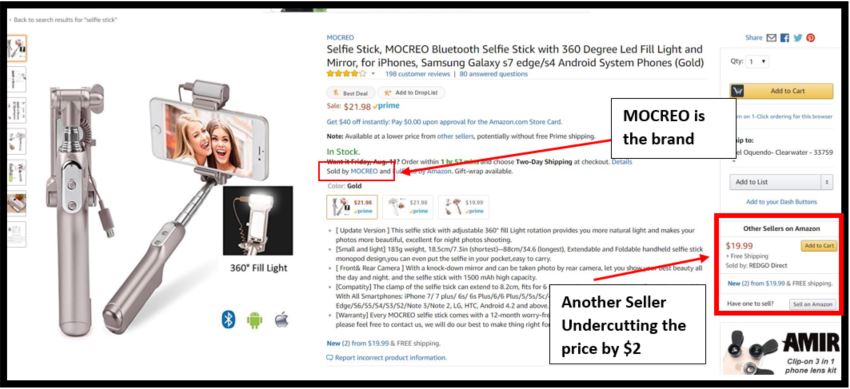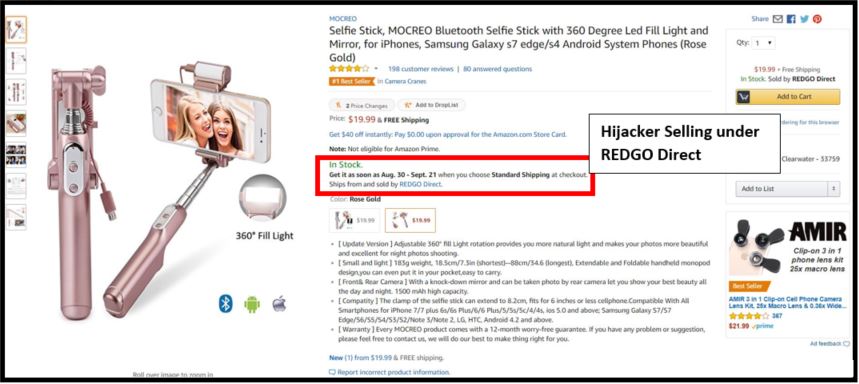If you’re looking to report an Amazon seller, then you’re in the right place.
In the Amazon business, we typically call them hijackers and they’re becoming a real threat. Unfortunately, it doesn’t appear they’re going away anytime soon. But don’t let this keep you from starting your own Amazon Business.
Maybe you started with Retail Arbitrage, then moved on to private labeling your own products only to discover that someone has been stealing your business!

The good news is that instead of abandoning the Amazon platform altogether and sacrificing boatloads of business, you can adapt and learn how to prevent these guys from overtaking your perfectly optimized product listing. And it’s hard enough finding a product to sell!
We should take a moment to differentiate between the two types of Amazon sellers you want to report. But, before we get started, here’s what we are covering:
Table of Contents
Who Are Amazon Hijackers?
Hijackers are the people using your ASIN (product listing) instead of creating their listing to undercut your price just enough to steal the Buy Box from you.
Typically, they can be Alibaba suppliers or Chinese counterfeiters and bots that are running on an algorithm, but some of them are Americans trying to get a leg up on your online success.
Second Type of Amazon Hijackers
Similarly, there are also sellers known as leeches.
Leeches don’t actually own the Buy Box, but they’re equally as annoying.
Many of these pests are bots without any history or feedback, most of which just launched a brand-new account right before they began assaulting yours.
However, there are many ethical hacks you can use to rank your new Amazon listing fast that isn’t considered hijacking at all.
What Does a Hijacked Amazon Product Listing Look Like?
Take this for example:
MOCREO sells a Bluetooth selfie stick under its own brand. Yet, we can see there are 2 other sellers for this product.

Here we see that MOCREO seems to be the original seller based on review-count. But REDGO Direct is selling the same product under the same brand for almost $2 less.

And if we look at their individual listings, we see they are almost identical. Except for the seller.

What Can You Do About These Amazon Hijackers?
You can’t just shrug your shoulders and say something like, “This is how the online marketplace is nowadays. There’s nothing I can do about it.”
Never give up on your business! You spent so much time trying to perfectly rank your Amazon product listing.
It’s time to defend your fortress.
The first string of defense that I always recommend is a simple cease and desist letter.
This might feel like the most obvious initial step, but many people don’t know how effective one of these bad boys can actually be.
If that doesn’t work, don’t fret! You still have three other plans of attack that are sure to do the trick.
And no, you don’t need a brand registry in order to implement them (although having one certainly wouldn’t hurt your odds).
My Top 3 Strategies to Report an Amazon Seller (a.k.a Hijacker)
Strategy 1: The Threatening Letter
The effectiveness of an email is very surprising!
If the scammer that is targeting your listing totally ignored your letter, their ears might perk up when they hear that same frustrated sentiment from another angle.
The secret? You need to send the email from your Amazon Buyer Account, which should be different from the seller account you used to send your Cease and Desist.
The hothead in you may want to go overboard with the harsh language, or you might be too much of a nice guy to lay down the law, but I’ve found it best to try and tread confidently in that firm middle ground.
You probably shouldn’t curse them out, but your goal when you report them is to let them know that they’re about to be in hot water if they don’t stop hijacking your Amazon product listing.
Here’s a template I use. Feel free to copy it word for word or alter it however you like, but rest assured that it’ll make an impact:
Threatening Letter Example
To whom it may concern,
Consider this your first and last warning to remove ASIN _________ from your Amazon seller account. Your account WILL be suspended if you do not comply. We have successfully gotten 12 other sellers like yourself permanently shut down in the last month for doing exactly what you are doing.
Is one product listing worth losing your entire Amazon seller account and business? I’m sure that it’s not.
Do the right thing and remove ASIN _________ or face legal action and the permanent loss of your Amazon account.
You have been warned.
Whether that tone comes off lukewarm or scalding hot in your eyes, it sure gets the job done.
Strategy 2: Report the Amazon Seller (a.k.a hijacker) to Amazon
When you first experience Amazon hijackers, your first instinct may be to report them.
However, it’s best to use this as your second string of defense. This approach is extremely effective for bots because they’re pretty identifiable as fraudulent when you take a moment to check out their account.
This doesn’t work as well for counterfeiters, mainly because they practically make a career out of looking and seeming legit. They’re basically professional liars.
All you have to do is email seller performance.
How to Report an Amazon Seller Inside Seller Central
Go to Seller Central > Help > Contact Us.
Select: Selling on Amazon > Other Issues > Report a Violation.
Keep it short and sweet, generally within two or three sentences. Drop a direct link to their storefront at the bottom of the email and mark it as urgent.
This approach tends to get results in just a matter of hours!
Strategy 3: Buy a Product from the Reported Amazon Seller
Now, the odds are that a dispute will never make it this far.
One of the previous methods should have fixed your problem by this point.
If not, it’s time to whip out the big guns.
🧠 PROTIP: Don’t waste this much time, energy, or effort on someone that doesn’t have the Buy Box. It just plain isn’t worth it.
The process can take several days, and if you actually do have a brand registry, you’re better off filing a trademark infringement claim instead.
The Exact Steps to Purchase From Your Amazon Hijacker
- Step 1: Purchase the product from the scammer in question and choose the fastest shipping option.
- Step 2: When it arrives, take a few photos that prove the item is fake and lacking your branding. If they actually managed to plaster the side with a bootleg version of your logo, just angle the item in your photos so that the logo isn’t visible. If that isn’t possible, you can try to Photoshop it out instead.
- Step 3: Call Amazon as a customer and open a counterfeit case against the seller. While you have them on the phone, demand a full refund. (Trust me, they’ll give it to you.)
- Step 4: Email seller-performance@amazon.com from your buyer account and include your photos, the order number, and the storefront URL.
- Step 5: In 48 hours, Amazon responds.
I know it sounds like a lot of hard work to keep a close eye on your listings all the time, but I’ve witnessed firsthand just how important it is to monitor these things.
What Else Can Amazon Hijackers Do?
Amazon scammers aren’t just stealing your Buy Box, you know.
They can change:
- Titles
- Product Images
- Descriptions
- Product Categories
- Reviews
They’re completely able to run any Amazon SEO plan you had in place. Some of them will even run a bot to thumbs-up negative reviews on your listing and delete authentic 5 star reviews!
These are tenured product hitmen we’re talking about here, and they will sabotage you from all sides. When you make a living in the world of e-commerce, there’s no room for negligence.
Solutions for Amazon Hijackers
If you simply don’t have the time to police your listings 24/7, tools like AMZAlert can keep a watchful eye on your store around the clock so that you don’t have to.
At the end of the day, whether you hire an online security guard or check your phone every 15 minutes, the surveillance will wind up being worth the trouble.
You work hard to achieve your ranking, and no international cyber-villain should be allowed to rob you of that.
Wrapping This Up…
For more info on the subject, read these 6 steps to protect your Amazon Product listing from Hijackers article, or you can grab some popcorn and check out this recent presentation I did with the StartupBros:
Just remember this: you aren’t powerless against fraud.
.
There are always measures you can take to fight back.
.
With these tricks, you’ll finally be able to fend off and report leeches, hijackers, and other internet creeps with ease.

How can I remove a hijacker who is using my ASIN so I can’t report a violation with brand registy because the forms won’t allow me to proceed because when I enter the hijacker url it says I can’t report my own product iv also sent emails and cease letters to the hijacker
What can we do with hijackers if our brand is not registered yet?
Hi Will! I found that using the brand registry reporting tool and claiming our trademark is next to useless in our experience.
What worked for us was reporting the “seller” to customer service for Amazon terms of service violation.
The support person transferred our ticket somewhere and they removed the hijacker within about 48 hours. I think if you frame it like Amazon is the harmed party they will act on it right away.
I mean, we’ve been reporting the hijackers and claiming trademark infringement for about 3 months and this is the only thing that worked for us.
Hey great tip! I’ll keep that in mind, maybe for an update 🙂
Will, I see that Amazon now blocks messages through Buyer/Seller Messaging that have other language besides Buyers asking questions about their product. They also have a statement at the bottom saying that an attempt to use the messaging for other purposes is against their terms. Although, there is no where else in their official terms of service where this is stated. Do you know of another way to reach out to the hijacker? I was thinking to try to use the “Attachment” section of messaging rather than the message box. My listing will be invaded in 2 days as their inventory will be arriving. Please respond soon if you can. Thank you.
Hey Andrea, yes absolutely we can help! Do me a favor and email bros@startupbros (dot) com and we can talk about it more in depth!
why don’t try a service in fiverr which can remove very quickly :
https://www.fiverr.com/davidshi904/remove-any-amazon-asins-hijacker-for-your-listings-fba-fbm
Hey David you’re absolutely right, it’s tough and you would do better with a patent. But we have been able to work with Amazon and send a letter to the seller with some success. It’s possible, personally, I think Amazon is improving.
Hello,
Thank you for all the great ideas. I have a bigger problem than I ANSI being hijacked. What I have tried so far is bundling my listings to keep them away, talking to them B2B, had my pictures U.S. Copyright protected and watermarked my pictures with the file number. All this did was piss him off and he is now on 80% of my plus or minus 200 listings. I tried Amazon’s infringement forms twice and all I get is the runaround. What is the next level I need to go to without branding my logo? Or is that the next level?
Thank You For Your Time,
Dave
Hey Dave, yes the next step would be creating a brand and registering your brand. That way only you can sell under your own brand.
As someone who is new to the game, I’m a little confused by what a hijacker is. Aren’t a lot of products on Amazon these days just sourced from China? So what would make someone a hijacker if I’m just sourcing from China as well? Or is this for more original products that then get copied by Chinese manufactures? If so, how do I as an out-sourcer, ensure that I’m not the one being the hijacker? And if there isn’t a trademark or patent in place, what makes it illegal or is it more of an ethical game? I certainly don’t want to do anything illegal or unethical so I’m trying to learn.
Hey Nick, two people can sell the same product on Amazon and create 2 different product listings without hijacking each other. When you list a product on Amazon you need a UPC code to create the listing. Then once your listing is created you get an ASIN which is an Amazon number that identifies your particular listing. If the other person used their own UPC code and got a different ASIN then you both have the same product being sold but with unique and separate listings.
Now, if that other seller decided to create a listing with no UPC code but instead create it using your ASIN then he would be hijacking your listing because he is selling the same product on your listing. I hope this makes sense! Let me know if you have any questions 🙂
I run a t-shirt business on Amazon and just had 30 designs hijacked by a Chinese scammer today. This is the third time in a month this has happened. The first two hijackers quickly took down the listings after I contacted them. Hopefully this hijacker does the same, because i know Amazon will never do never do anything about it. If this continues my business will eventually be ruined.
Same thing now happens with my accout. Have 3 hijackers to fight with. Sent them a letter – no result. Reported to Amz form/phone – no result.
Hey Serge, any update on your situation? Has it improved? I would consider reporting multiple times.
Hey Nathan, any update on this situation? Have you tried reporting the sellers to Amazon even though you think they won’t help?
Your first tip of using a different email as a buyer and as a seller may get people into trouble. I had a buyer account for years, and created a seller account with a different email. A few weeks later Amazon found out and banned me from selling permanently. It took me months to finally convince them to allow me back in, and this was only possible if I kept the same email. Hope this helps!
Okay, so I have a registered LLC through which I sell. It has its own domain with own emails with that domain and of course I’ve registered my seller account through a business email, which is different from my personal email that I use as a buyer. What can we do in such a case? They can’t force me to tie my personal account with my legal entity – they have nothing to do with each other
Hey Dan, it shouldn’t be a problem anymore. That was something that we have worried about in the past but Amazon is smart enough to know who you are based off your IP address and different emails shouldn’t get you banned.
Hey Federico, it’s possible that people might get penalized but we have spoken with a representative from Amazon and they said it shouldn’t be a problem anymore 🙂 But thank you for keeping an eye out and helping all of us out!
Hey Steve, thanks for the read. I’m having an issue with an Amazon seller of the same ASIN as me creating alternate buyer accounts, purchasing my ASIN on multiple orders and repeatedly leaving negative feedback to lower my metrics. He’s been doing this to multiple sellers actually and now has started filing policy complaints, etc. All of his orders are shipped to the same address, so he’s not even trying to hide these tactics. Any input on what I can do? I’ve already contacted all of Amazons departments, provided screen shots of the orders addresses and the sellers location being in the same area, etc. But they seem to do nothing.
Hey Daniel, has your situation improved at all? We partner with AMZ Alert and they have helped us out of some difficult situations. I would say that you can reach out to their support and they would be more than happy to help!
Thanks for sharing valuable information. I have recently started selling on Amazon and this would really help me in future to protect my listing.
Hey Ketan, thanks for reading the article 🙂 If you ever need to report a seller on Amazon you know where to go now!